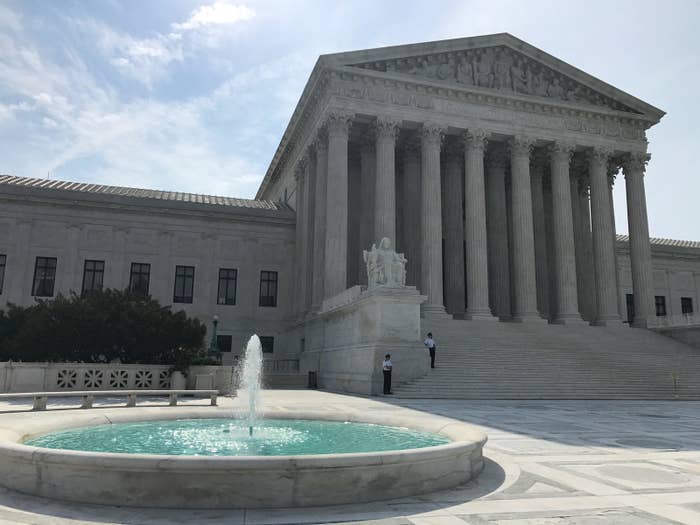
The Supreme Court justices met Thursday in their private conference to discuss what to do with pending requests before them.
What do we know?
One big request before the justices comes from the Trump administration, which has asked the justices to allow enforcement of Trump's travel and refugee bans and hear its appeal of cases challenging the March 6 executive order.
The 90-day ban on travel from six majority-Muslim countries and the 120-day halt to the refugee program — as well as Trump's reduction in the total number of refugees allowed into the country this fiscal year — are on hold following a decision from the US Court of Appeals for the Ninth Circuit partially upholding a trial court's injunction. The Fourth Circuit, in an earlier decision, also had upheld an injunction halting enforcement of the travel ban part of the order.
And, before we get to the questions, one more important thing to know: The Supreme Court is expected to recess for the summer next week — with at least some justices already having plans set to leave town in early July. (More on that later.)
Need more background on what's being argued in the travel ban arguments? Read this first!
Are the justices actually considering what to do with the travel ban on Thursday?
We don't really know. The court didn't announce on the docket whether it was going to consider Thursday the request of the federal government to hear the case — a petition for a writ of certiorari — and applications for stays of the injunctions do not normally get a public notation of when they're being considered.
That said, the quick timeline given by the justices for the parties to submit to a final set of filings on Tuesday and Wednesday of this week suggest a desire to consider, at least the stay requests today.
So, if they do consider the stay requests, what does that mean?
It would mean that they are considering whether to allow the Trump administration to put the travel ban and refugee ban in effect while the justices consider what to do with the underlying challenges to the executive order. Granting stays of the lower-court injunctions would require the vote of five of the nine justices. (Hearing the underlying cases, however, only require the votes of four justices.)
What could they do?
This is where it gets a little complicated.
Being the Supreme Court, they can pretty much make up a lot of the rules as they go along and do what they want. But, in this situation, most obvious paths ahead cause complications or at least unusual circumstances.
If the justices allow the bans to go into effect by granting the stays and planned to hear arguments over the underlying challenge when they return in the fall, then it would be more than 90 days before the justice even would hear the case. After nearly six months of litigation and stays from courts across the nation, the decision about the stay would effectively resolve the case — at least as to the travel ban — before the justices even heard the case.
If the justices deny the stay request and plan to hear arguments over the underlying challenge in the fall, a different complication would occur. Because the Ninth Circuit has allowed the Trump administration to begin the internal review process for travel and refugee vetting that was called for under Trump's executive order, the 90 days the government had planned for the travel review would pass before the Trump administration could argue to the justices that the ban is allowed during the review.
Whether they grant the stay or not, the justices also could hold expedited arguments — as suggested by law professor Josh Blackman — to resolve the underlying question in short order. However, it's not exactly clear why the justices would take such an approach when the government itself hasn't asked for expedited review of the underlying case.
What's more, the Justice Department did not exactly rush the case to the justices, waiting a week to ask the justices to put the injunctions on hold and hear the appeal after the Fourth Circuit ruled against the travel ban. (Earlier, the administration also had waited more than a week to request a stay of the initial district court injunction at the Fourth Circuit.)
And, again, the justices are slated to leave for the summer as soon as next week, so a decision to hear the case immediately would require some scheduling adjustments that the justices might not want to make given the Justice Department's delays in bringing the case to the justices.
(There are some other paths the justices could, theoretically, pursue, but those are the most likely possibilities.)
OK, bottom line: When will we know what they're doing?
We don't know.
It could be as soon as Thursday afternoon, after the conference has ended and any written order is prepared.
It could come sometime Friday — since the court announced it will be in session to issue decisions from one or more of the remaining nine pending argued cases from this term.
Or, it could come at 9:30 a.m. Monday, when the court generally issues its orders from the prior week's conference.
Or, if the matter requires further discussion (or if they didn't even discuss it today), the justices could consider the issue again (or for the first time) at its expected final conference before recess, which could come as early as Monday. That would mean we would expect word on a decision either that afternoon or at 9:30 a.m. the next morning.
In short, we'll know when we know. Any guesses before then are just that.

